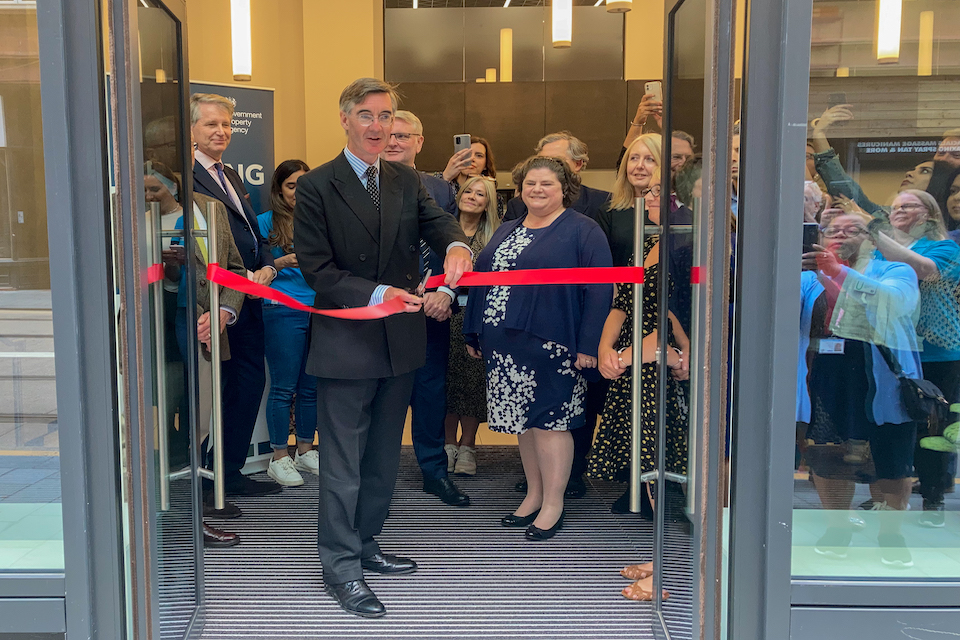|
|
 A new ability swing for wheelchair users at the new Roman Play Villa in Castle Hill is to be installed as part of Ipswich Borough Council’s commitment to inclusivity. A new ability swing for wheelchair users at the new Roman Play Villa in Castle Hill is to be installed as part of Ipswich Borough Council’s commitment to inclusivity.
The ability swing allows wheelchair users to swing alongside a flat-seated swing and so enables side-by-side inclusive play – a key aim of the Council’s Play Area improvements.
This is a new type of equipment for the Council’s Play Areas and follows consultation about a swing to meet the needs of independence and inclusivity. This consultation will continue once the ability swing is installed to ensure that it is the correct piece of equipment, can be used effectively and should also be used at other locations.
The swing is used with a RADAR key. There is also signage and a QR code that leads to a YouTube link to help ensure correct use.
Castle Hill is the first of the Play Areas to be upgraded and with works currently underway. The inclusion of the ability swing will not delay the planned opening of the new park in Autumn 2022.
The cost of the ability swing is being met by the agreed budget for the Play Area and that is part of Ipswich Borough Council’s Play Area Strategy and Action Investment Plan that was agreed by the Council in March 2022.
This Play Area Strategy includes standards for inclusive play areas and the introduction of new equipment suitable for all abilities. including ramp access, ability swings, sensory and quiet play sections as well as colourful and textured areas.
Cllr Phil Smart, Ipswich Borough Council Portfolio Holder for the Environment, says:
“This great equipment has a platform for a wheelchair that enables a child to swing without needing to lift themselves or be lifted into a seat. Their friend can also swing alongside them. As well as helping independence this also makes for a more inclusive experience.
“This is the first swing of this type to be installed in Ipswich in the first Play Area to be improved. The Council’s Play Area Strategy will deliver a timetable of improvements over the next five years and with an emphasis on inclusive play for all ages and abilities.”
For more information about Castle Hill please visit: A new Roman-themed play villa to open at Castle Hill, Ipswich | Ipswich Borough Council
 Katial House Islington Council has worked with Comelit-PAC to create a cloud based door entry solution for managing access control to communal residential developments across its housing portfolio.
As a leading London Borough Council, Islington has made the transition to a PAC cloud solution across its housing network, delivering improved security for residents.
Initially, PAC pilot tested the system across six blocks chosen by the council’s capital works team. The pilot was successful in working around residents to ensure a seamless transaction of fobs and secure access to communal areas. The works have now been extended to more locations across the borough.
With the ongoing programme, Islington Council is committed to safe and secure housing for residents across the borough. The PAC security system can accommodate the high frequency movement of residents and operators who may need controlled access to communal areas. Overall, the PAC installation offers greater peace of mind and safe audit control.
The London Borough of Islington has been using PAC systems for over 25 years, with the team working closely with technical services from specification to installation, ensuring a seamless transition from the existing standalone system to the smart cloud based solution.
From the borough’s perspective, the remote capability enables a much more efficient approach to managing access throughout our properties, enabling resident instant access, and old resident details can be removed and replaced as necessary.
At the same time, Islington has peace of mind that data captured is secure in the cloud, in compliance with latest standards.
Paul Scott, Sales Manager at Comelit-PAC added: “The benefit of the long term relationship we share with The London Borough of Islington, is that we understand their requirements, from a technical and operational perspective. We also have come to know their processes to ensure resident safety across its housing network.
“The new cloud system enables the Homes and Neighbourhoods team to operate more efficiently, especially with the new focus on hybrid working. It also comes with the assurance that all data is safely stored and backed up, secure and accessible, even remotely when they are not on site. This means they can respond quickly to resident’s needs for new or replacement fobs, and ultimately secure access to their home.”
 Barley Laing By Barley Laing, the UK Managing Director at Melissa
As public sector services become increasingly accessible online due to the pandemic and improving technology, there has been a corresponding growth in fraud. According to the Cabinet Office fraud and error in public spending are estimated to cost the taxpayer up to £51.8 billion every year, which is larger than the UK’s annual defence budget.
With precious budgets under risk from fraudulent activity, undertaking effective ID verification, behind the scenes in real-time when people sign-up for a service, has become an essential.
Forward thinking public sector organisations are already using identity verification services, such as electronic ID verification (eIDV). These tools deliver cross-checks against an individual’s contact data in real-time, as they complete an online application process, whilst ensuring the user experience isn’t compromised.
Clean data powers ID verification
While undertaking ID verification will remain vital, the cost of it can be reduced and fraud will much less likely to occur for those that have ongoing processes in place to ensure data hygiene. For example, address validation, for proof of address, is about matching a name to an address, and is a crucial part of the data hygiene process. It highlights those who provide an inaccurate address, whether that’s because of a typo or they have entered an inaccurately formatted address, which then can be easily corrected. It also flags those who are providing an address they are not associated with, therefore potentially providing an inaccurate address for fraudulent purposes.
Because ID checks will pick up rudimentary things, such as an incorrectly formatted address, it’s much better value and best practice to ensure you have accurate user contact data in the first place, prior to undertaking ID verification.
A data hygiene first approach is not only important for identity verification. Accurate data on users also enables the public sector to obtain valuable insight, such as a single customer view (SCV). This insight can be used for better targeting, including personalisation with communications.
Unfortunately, 91% of organisations have common data quality problems, with user contact data degrading at 25% a year without regular intervention. Also, 20% of addresses entered online contain errors, such as spelling mistakes, wrong house numbers and incorrect postcodes.
The good news is incorrect contact data, such as name, address, email or telephone number, can be easily fixed, often with simple and cost-effective changes as part of their data quality regime. This should involve cleansing and standardising held user data to deliver data quality in batch, as well as when new data is collected, in real-time. The cleansing tools used in this process should be able to enhance the data by filling in any missing contact details.
Four steps to clean databases:
- When it comes to the data cleansing process one of the most useful tools for the public sector is an address autocomplete or lookup service, which enables address validation. These can gather accurate address data in real-time at the onboarding stage – vital during a period when many people are completing contact forms on small mobile screens where they are more liable to make mistakes. They also enable those in the public sector to deliver a standout service by reducing the number of keystrokes required—by up to 81 per cent—when typing an address. This speeds up the onboarding process, reducing the probability of the user not completing an application or making a purchase.
- Duplicate data of those on your database can be an issue. It’s commonly caused when two departments merge their data and by mistakes in contact data collection at different touchpoints. This adds cost in terms of time and money, particularly with duplicate printed communications, which can also adversely impact on the sender’s reputation. The recipients will see this as a waste of public money, at what is a challenging time for public sector finances. To prevent this, source an advanced fuzzy matching tool to deduplicate data. By using such a service, and merging and purging the most difficult records, you save money with communications and improve the user experience.
- Data suppression strategies help those in the public sector highlight people who have moved or are otherwise no longer at the address on file. As well as removing bad addresses, services that include deceased flagging ensure mail and other communications are not sent to those who have passed away, upsetting their friends and relatives. It’s not only ethical to use these suppression strategies, but it also helps public bodies to save money and protect their reputation.
- Once you’ve deployed the basics to ensure accurate customer data, artificial intelligence (AI) can add even greater value to the data you hold. For example, a type of machine learning called semantic technology can readily deliver high value, in-depth intelligence on users of your services. Semantic technology, or semtech, associates words with meanings and recognises the relationships between them. It operates by delivering powerful real-time connections between records, combining the missing pieces of data to support an informed decision about the content of a communication to a user.
A data hygiene first approach is vital for ID verification. It’s only by having clean data that you can effectively, and at low cost, undertake identity verification, and reap the additional benefits of having accurate user data, such as improving targeting and delivering a better experience for those using your services.
For more information about Melissa and how our data quality and ID verification services can help you not only clean your data but prevent fraud, please visit: Melissa, email: barley.laing@melissa.com or call: 020 7718 0070.
 Ransomware has long been a menace and has even led to some referring to it as the digital plague of our time. The constant barrage of cyberattacks in the last few years has raised concerns, particularly for organisations that must get to grips with the tactics used by threat actors trying to gain access to their networks. Ransomware has long been a menace and has even led to some referring to it as the digital plague of our time. The constant barrage of cyberattacks in the last few years has raised concerns, particularly for organisations that must get to grips with the tactics used by threat actors trying to gain access to their networks.
Cybercriminals have no remorse for their victims so long as they get their ransoms paid. According to one report, the average ransom demand increased by 144% in 2021 to US$2.2 million, while average payment rose 78% to US$541,010. This just goes to show how lucrative and effective ransomware can be.
But what is causing these organisations to fall victim to ransomware? Looking into the top causes for ransomware, KnowBe4 revealed social engineering to be the most successful vehicle for hackers to dupe victims. Social engineering involves cyber threats like phishing via email, smishing via text message, vishing over the phone, or a combination of any of these tricks to get employees to click on a malicious link. We have even seen examples of employees being offered bribes to install ransomware.
Now, there is no silver bullet in cybersecurity that will magically prevent all these threats. You cannot just throw money at technology alone to try fix the problem. Organisational policies and procedures need to bake in security. The most important strategy that needs to be adopted is to develop and increase user awareness of ransomware threats which can help create an added layer of security for the organisation.
Do not rush; security takes time
It can be difficult to trust the process of building security awareness. It can feel like an obstacle that could be avoided by investing in just security technology. Yet, decision-makers have to realise that a positive security culture is an enabler for business operations. Without this element, you will be left vulnerable. It cannot be viewed as a “nice to have” feature or an afterthought just to tick a compliance box. 
Dedicating even a small amount of time in a week for security awareness training can make a difference. Having the workforce learn from a variety of resources and tools about security policies, best practices and tell-tale signs of ransomware, and other threats, will help.
People are just as important as the tech
Empower your employees with the right knowledge to make a difference. Within the organisation, they should be viewed as security enablers who can be an integral part of any security program. Do away with the stigma that they are the chinks in the security armour, as this only happens if they are not properly trained.
Security training can be inexpensive and does not need to eat into the security budget, as there are plenty of free or cheap resources to aid security teams in getting the message across. Better yet, these resources come in a variety of formats, from videos and quizzes to checklists and articles. There are even security policy templates that can be downloaded for free. All it takes is a quick search on the internet. Yes, these may be basic or rudimentary and may lack the glamourous features if you were to purchase a subscription with a vendor, but it can definitely help form a foundation of security awareness to build from.
Free tools are available
As mentioned, organisations of all sizes should utilise the free security training tools available to better prepare the workforce against ransomware and other cyber threats. For instance, try ransomware simulators to test the preparedness of the business, assessing how the team would manage such a scenario. Look at password checkers that are widely available for free to see the security effectiveness of the passwords being used in the organisation. There is a plethora of free security hygiene and best practice modules that cover all these areas and more. You can even get security vendors to provide free security consultations with free scans of the network and infrastructure to flag the biggest risks. Yes, a sales call may be required, but having this conversation can save you both on costs and resources, while making you more secure.
Ransomware is a huge issue and there are no signs of it slowing it down so long as it is effective, and since criminals are seeing a return on their investment, it will be here to stay. Thankfully, there are options – some of which are free – to help organisations reduce the risk of being impacted. Make security a business priority and give the workforce the knowledge and ammunition to defend against these social engineering threats.
To give you and your organisation a head-start, KnowBe4, the provider of the world’s largest security awareness training and simulated phishing platform, has created a resource kit as part of a month-long effort in July to increase awareness of ransomware. Some of the resources for download include a Ransomware Master Class, Ransomware Rescue Manual, infographics, posters, digital signage and more.
To download the KnowBe4 Ransomware Awareness Month Resource Kit, visit www.knowbe4.com/ransomware-resource-kit?hs_preview=jWLYMIeR-76301550774
South Tees Hospitals NHS Foundation Trust has taken the next step in its modern, modular electronic patient record (EPR) programme with Alcidion, having gone live with electronic prescribing and medication administration (ePMA) system Better Meds.
The trust has deployed Better Meds to inpatient and outpatient areas, where it is already removing paper forms and manual processes, as well as helping busy healthcare professionals to make safe prescribing decisions.
The ePMA solution fully integrates with Miya Precision, Alcidion’s EPR, which is being deployed across the trust to advance digital maturity in ways that respond to clinical priorities and alleviate pressures faced by clinicians. The trust has also simultaneously gone live with electronic discharge notification functionality within the Alcidion Miya Precision system.
Daniel Pugh, a senior informatics pharmacy technician for South Tees Hospitals NHS Foundation Trust, said: “There is a lot of excitement across the trust about the possibilities from this ePMA implementation, and other digitisation taking place in South Tees Hospitals.
“Integrating electronic prescribing into our Alcidion EPR, joins up drug information with patient assessments, allergies, lab results, vital signs and more. This provides a safety barrier that will help prescribers make better informed decisions for patients. It will also save valuable time for clinicians, for example, through easy access to standardised order sets and the ability to prescribe from anywhere.
“Electronic discharge will also become much easier for doctors. Rather than having to manually transcribe medicines, staff just open a discharge letter in Miya Precision, and all the drugs for a patient appear. This reduces the risk of errors and represents an improvement in patient safety.”
The trust will now benefit from a better audit trail of every medication dose administered, and staff across wards will gain easier visibility of when medicines are due for patients. “Some medicines require administration within a strict timeframe, for example, drugs related to Parkinson’s disease,” said Pugh. “We will be able to monitor that and many other scenarios. Trend analysis will allow us to easily identify any potential issues early so we can act swiftly and provide more resources to a ward when needed.”
Codified data will also support the trust in financial reporting, so that it can more easily link medicines to specific patients and reclaim money that can be reinvested into patient care.
The ePMA implementation epresents an important step on the trust’s journey through stages of the HIMSS Electronic Medical Record Adoption Model. A whole range of additional functionality will complement the go-live as the trust continues to progress its deployment of Miya Precision.
Dr Andrew Adair, chief clinical information officer, at South Tees Hospitals NHS Foundation Trust, said: “E-prescribing is the latest important step on our modular EPR journey, that is allowing us to move at pace towards the highest levels of digital maturity through technology that people want to use.
“Better Meds is highly synergistic with our Alcidion Miya Precision system – and will integrate closely with e-noting, e-observations, patient flow journey boards and more, in ways that reduce the cognitive load for clinicians by making information useful and supporting clinical decisions. Responsibility for prescribing decisions still rests with the clinician, but they will no longer need to manually manage every detail and every process about medicines, conflicts and interactions, guidance and more.”
Roko Malkoč, business unit director, Better Meds, added: “South Tees Hospitals NHS Foundation Trust has shown high digital transformation maturity, resulting from the excellent internal alignment driven by an experienced team. We believe that collaboration with Alcidion in the trust will bring direct benefits with real-time access to all healthcare data for caregivers. Both encourage us to follow our vision of medication management without errors.”
This deployment represents the first NHS trust to implement an ePMA module as part of an Alcidion EPR programme.
Lynette Ousby, UK managing director for Alcidion, said: “Digitisation in healthcare should be about using technology to respond to clinical and operational priorities in the right order for NHS customers. In this case, e-prescribing will help staff to safely get the right medicines to the right patient, at the right time. South Tees Hospitals is a strong example of a trust that is delivering technology to respond to the needs of its clinicians. Doing that effectively requires flexibility from technology providers and a willingness to work together. It’s really rewarding to see the benefits of a modern, modular approach to digitisation working so well in practice.”
Kate Quirke, CEO for Alcidion, said: “I’m impressed by the speed at which South Tees Hospitals is progressing its digital journey, and by the enthusiasm for digital transformation at all levels of the organisation. I look forward to seeing the impact of this latest stage of the trust’s programme, and to further developments in the near future.”
By Chris Hornung, Managing Director of Public Sector Business at Totalmobile
In recent months, there’s been a lot of hot debate about how the Metaverse is set to transform how we work, play, shop, socialise, transact, and more.
Featuring the confluence of multiple technologies including 5G, artificial intelligence (AI), the internet of things, blockchain, virtual and augmented reality, 3D graphics, machine learning, VR-enabled headsets, and quantum computing, the Metaverse aspires to provide highly immersive and embodied online experiences. So far, so good. But what does all this marketing speak really mean?
Essentially, the Metaverse builds on ‘old school’ digital gaming concepts to enable highly responsive virtual and augmented reality spaces where users can virtually meet, work, learn – and potentially gain access to public services.
 Indeed, according to Mark Zuckerberg, co-founder and chief executive of Meta (aka Facebook), the Metaverse is “an embodied Internet where you’re in an experience, not just looking at it.” If you’ve seen the film The Matrix, you’ll have some understanding of the scope and ambition of the Metaverse vision: a virtual digital world in which people can live out their daily lives via avatars. Indeed, according to Mark Zuckerberg, co-founder and chief executive of Meta (aka Facebook), the Metaverse is “an embodied Internet where you’re in an experience, not just looking at it.” If you’ve seen the film The Matrix, you’ll have some understanding of the scope and ambition of the Metaverse vision: a virtual digital world in which people can live out their daily lives via avatars.
If that all sounds a bit like far-fetched science fiction, then think again. Because the art world is already experimenting with NFTs (non-fungible tokens) that represent a unique digital representation of a work of art. Indeed, many art investors are betting that NFTs will revolutionise how art is viewed, owned, and traded.
From fiction to fact – going beyond the hype
For the past two decades, the online gaming world has been pushing forward the boundaries of what is possible where gamification, immersive virtual experiences, and alternative worlds are concerned. However, recent developments in super computing – combined with digital blockchain and decentralised Web3 technologies – are now set to unlock the true potential of Metaverse platforms. Delivering a new era of real-time interactive 3D digital human experiences and simulations that go far beyond how we interact virtually today.
Unsurprisingly, big tech and gaming companies are hoping to play a leading role in shaping the Metaverse future while capturing a market lead in what’s hotly anticipated to be the ‘next big thing’. Indeed, it’s the reason why Facebook took the decision to rebrand itself as Meta in 2021.
But with so much being written about Metaverse potential use cases, to all practical intents the Metaverse today remains very much a clunky ‘work in progress’. Plus, there has been much debate about whether consumers will be ready and willing to interact, transact, and participate in these eagerly anticipated new digital ecosystems.
One thing is for sure. Alongside addressing a lot of tech-related interoperability challenges, kickstarting the mass take up of the next generation of Metaverse experiences will be dependent on the development of new legal frameworks and regulatory rules that will protect users in these virtual worlds. Unsurprisingly, issues like user privacy, data protection, digital ID, ethics, and cybersecurity are all top concerns, especially where children and young or vulnerable adults are concerned.
Which is why agencies like the UK government’s Digital Catapult are bringing together key stakeholders from industry, academia, and regulatory authorities to examine how best to support Metaverse innovations, while ensuring that ‘safety by design’ standards are embedded into Metaverse platforms and technologies.
Think evolution, rather than revolution
For government and public sector organisations, the Metaverse can seem like a significant leap from a service delivery perspective. The good news is that there’s no need to decide whether or not to buy a Metaverse ticket and get on the train right now. However, being aware of the technologies and products that are set to shape the future of UK digital service delivery is no bad thing.
In the past two years, government and public sector organisations have undergone rapid digitalisation that’s transformed service delivery and citizen/user interactions. In parallel, many organisations have begun experimenting with powerful virtualisation and cloud distribution technologies to deliver new immersive experiences in a variety of fields – think online digital exhibitions and arts catalogues, or digital twins and learning and digital skills programmes.
In the future, chatbots and virtual digital assistants that are now everyday features of contact and support centres may be supplemented by online virtual assistants that ‘meet’ and help service users in the Metaverse. Meanwhile, remote employees can literally meet colleagues in the Metaverse or join virtual immersive representations of their workplace/office.
Providing a potentially rich opportunity to enhance communication and engagement with citizens and service users, the Metaverse is a book that’s waiting to be written. Offering the potential to revolutionise healthcare, education, tourism, smart cities, social and political engagement, and more, initially most organisations will first look to harness the benefits of the Metaverse to enhance traditional processes and improve citizen centricity. After which, the deployment of universal digital platforms that support individuals and commercial entities in new and highly distributed ways may see the Metaverse expanding in new and unexpected ways.
 Transparency, cost control and fulfilling short notice staffing requirements in as little as 1-2 hours are just three of the main benefits City of Cardiff Council has accomplished since it started working with recruitment technology business Matrix in 2016. Transparency, cost control and fulfilling short notice staffing requirements in as little as 1-2 hours are just three of the main benefits City of Cardiff Council has accomplished since it started working with recruitment technology business Matrix in 2016.
Matrix, which specialises in the procurement of temporary, interim and permanent staffing solutions, provides a neutral vendor managed service and end-to-end process in one complete platform, allowing clients to take control of their recruitment with full visibility.
“Matrix delivers a neutral vendor managed service provision which supports the Council with transparency, cost control, short notice requirements and many other benefits,” says Shauket Ali, category manager, City of Cardiff Council. “Since going live with Matrix, they have delivered savings and efficiencies while managing £26m annually for the authority.”
Prior to awarding the contract to Matrix, the City of Cardiff Council felt a lack of support from the previous incumbent – there was no guidance through the ordering process, no support with cost control and an inability to meet short notice requirements. This resulted in a lack of faith from Hiring Managers, which resulted in poor attendance of training sessions.
To overcome these challenges, Matrix ensured that the Council received the best support available during implementation of the new solution and has consistently been working to improve processes, which included the systemisation of placement extensions. It also provides real-time reports with a detailed cost breakdown.
Working in partnership with Cardiff Council meant that Matrix was able to achieve full buy-in from the Hiring Managers, providing extensive training to Hiring Managers as well as an onsite Account Manager to assist them with any requests or issues they faced. Through this service, it has been able to introduce savings to the council and provide them with high quality workers – meeting any short notice requirements through its cr.net platform.
In the previous 12 months, Matrix has transacted over 21,000 hours within the hospitality/operations category at Cardiff Council, delivering a 99% fulfilment rate – sometimes in as little as 1-2 hours. It also delivers a number of shift workers with over 40% of Cardiff Council’s annual spend within more low skilled workers and operational shift cover – which are often required within a 24 to 48 hour time period.
Since partnering with Matrix, the City of Cardiff Council has been able to achieve a 99.3% fulfilment rate and £5.7m (4.1%) in cost savings. The number of placements created have consistently outperformed the number of orders raised over the past six years.
“Working in partnership with the City of Cardiff Council, we were able to overcome the initial hurdles and restore faith among key stakeholders with the implementation of our system,” says Ian Middleton, national business director at Matrix. “By streamlining the process through our software we are able to provide transparency, real-time reporting, cost savings and a fast fulfilment rate.”
Ian Hogan from the Northern Care Alliance and Neil Perry from Dartford and Gravesham NHS Trust have joined the forum that debates the big issues facing health tech and seeks to spread innovation for the future
Two of the NHS’ most dynamic chief information officers have joined Highland Marketing’s advisory board of NHS IT professionals and health tech industry experts.
Ian Hogan, a CIO at the Northern Care Alliance NHS Foundation Trust and Neil Perry, the director of digital transformation at Dartford and Gravesham NHS Trust, have joined the expert group that acts as a discussion forum for issues relating to digital health and provides advice to the agency and its clients.
 Ian Hogan Hogan said he was looking forward to joining the board’s regular debates, which range widely over NHS IT policy, technical developments, and enablers such as tackling digital inequality.
“Highland Marketing has found a really interesting group of people to sit on its advisory board, and I’m looking forward to hearing their views on the challenges that NHS IT is facing,” he said.
“We need new voices with new ideas in health tech, and I believe the advisory board is committed to finding them. When I was invited to join, it seemed like a great opportunity.”
Perry said he was looking forward to drawing on the advisory board’s combined experience of NHS IT developments and deployments, and its interest in innovation.
“One of the big challenges in NHS IT is the need to balance the deployment of familiar technologies with seizing the opportunities presented by innovation, whether that’s AI, or remote monitoring using the latest wearables,” he said.
“I think the advisory board gets that, which makes it an interesting forum for discussing the hard reality of some aspects of health tech policy and the exciting future that could be ahead of us if we can get this right.”
 Neil Perry Hogan has worked in healthcare technology in the North West since mid 1990. He joined what is now the Northern Care Alliance NHS Foundation Trust in December 2019, and works across its digital portfolio.
Perry has also worked in healthcare technology for around 25-years, but in the South East of England, where he has worked on traditional ‘single system’ electronic patient record developments and on alternative approaches.
He joined Dartford and Gravesham NHS Trust in 2007 and, as director of digital transformation, is working to deploy Alcidion’s open platform and Patients Know Best as the foundations for a modern, modular EPR that can layer in innovation.
Jeremy Nettle, the chair of the Highland Marketing advisory board, said: “It’s great to welcome two, new CIOs to the board. Ian and Neil are taking very different approaches to digitising their organisations, but they both have great experience and commitment to delivering for their users.
“I am looking forward to hearing the fresh perspective that they will bring to our discussions and to giving them a voice in the wider industry.”
Susan Venables, founder and client services director at Highland Marketing, said: “Highland Marketing is a specialist health tech marketing, PR and communications agency. Health tech is all we do, so we have a deep commitment to finding ‘health tech to shout about’ and to communicating it to the people who need it.
“The advisory board has become an important forum for shaping our work, so I’m very grateful that Ian and Neil have chosen to join us. I’m also looking forward to hearing their views about the digital future that we all want to see.”
NCC Replaces Paper and Spreadsheets to Digitalise Facilities Management Across 89 Buildings and Over 40 Schools
Northumberland County Council, serving over 2,000 rural square miles, has completed a successful pilot and is now deploying field service management solutions from Totalmobile to digitalise its facilities management (FM) operations and link the FM business unit with other council services.
Scheduling, job management and mobile solutions from Totalmobile are being rolled out to manage audits, property checks, and reporting. This will enable a single point of information in the form of a dashboard, which will enable management teams to view a complete service picture at any given time.
Prior to the pilot scheme, the recording of building checks took place on paper and were recorded in spreadsheets and logbooks. Checking the status often required physical on-site visits. The new solution will enable full visibility of all FM operations such as fire safety checks, lift checks, and Covid cleansing, and enable greater transparency of performance, underpinning critical decision making.
Susan Treadwell, Interim Facilities Manager at NCC said: “We chose Totalmobile as we wanted one solution for all services, a solution that worked offline, removed duplication, and had the ability to capture photographic evidence.
“We run facilities management across a vast rural area. It is vital that we meet health and safety regulations and requirements, and buildings are properly maintained in the most time- and cost-efficient ways. 
Northumberland has been a Totalmobile customer for other service areas for over six years. It currently uses the technology within nine different service areas including neighbourhood services, property services, social care, fire and rescue, housing, and election services to work offline, remove duplication and have the ability to capture photographic evidence.
Chris Hornung, MD Public Sector at Totalmobile said: “We are seeing an increasing demand for field service intelligence technologies that improve community experience, simplify compliance, and, ultimately, provide a better service across all areas of a local authority. The wide variety of services that NCC is using Totalmobile across reflects the service, quality and significant benefits that field service management software can deliver. ”
 Julian Boneham By Julian Boneham, Technology Practice Director – Data, at Node4
Following the biggest year of UK electric vehicle (EV) consumer market sales and the COP26 climate conference, 2022 is set to be a defining year for EVs.
Backed by the UK government’s ambitious emission-free measures, and a £1,500 plug-in-car grant for new EV car purchases, the EV market is booming in the UK. Last year saw EV car sales increase by 76% and, according to the UK automotive trade body The Society of Motor Manufacturers and Traders (SMMT), electric cars are projected to outsell diesel models by the end of 2022.
As the UK prepares itself for the 2030 ban on new petrol and diesel vehicle sales, followed by a further proposed ban on the sale of new hybrid vehicles by 2035, investment in the UK’s charging infrastructure is ramping up fast to cope with the anticipated demand that will go way beyond the estimated 400,000 EVs and more than 750,000 plug-in hybrids on the road today.
In the coming years, the public charging network will need to be upscaled radically to ensure an appropriate level of infrastructure is in place to support current and future EV car owners.
A sizeable business opportunity
With just over 20,000 charge points in the UK at the end of 2021, the Committee on Climate Change (CCC) estimates that, by 2030, 325,000 public charging points will be required to support the needs of EV drivers.
Alongside providing fast charge options at petrol and service stations to meet the requirements of those on long-distance journeys, the CCC has identified a growing need for public ‘top-up’ charging facilities in public parking spaces. Plus, a growing number of drivers that are unable to charge their vehicles at home, for example, if they live in flats, will need certainty that they can easily access a public charging network.
All of which creates new opportunities for supermarkets, shopping centres and other businesses for whom the provision of public chargers would help attract customers and demonstrate a businesses’ green credentials. Similarly, local authorities may also want to install chargers in the car parks they operate and in residential streets with available parking.
With demand set to grow exponentially, improvement in the EV support infrastructure is becoming a critical focus area and providers are jostling for position. EV charging service providers that make it possible for EV drivers to plug and charge their vehicles from different charging networks are growing, as are schemes featuring subscription services, apps and membership cards.
This means that the infrastructure that is put in place will need to support drivers, regardless of which scheme they are – or are not – a member of, to ensure that drivers can use any and all types of charger. But that’s just the start.
The top 3 critical criteria for EV charging infrastructures
The EV industry has a way to go to reassure prospective vehicle owners that they can effectively charge a vehicle in a single stop. With a variety of charging choices on offer, the supporting technology for app and charging services must fulfil three vital criteria. Today’s consumers will expect to encounter public charging services that are seamless, reliable and secure.
1. Service availability – trust is a key element for EV drivers, many of whom are making their first venture into this new territory. Drivers will not tolerate apps that aren’t seamless or always available, so any charging technology that is deployed will need to be highly available 24/7/365 days a year. To ensure this, service providers must host core IT in highly available environments that can provide at least 99.99% uptime and 24×7 support to ensure they can remedy any customer issues and maintain brand reputations.
2. Technology performance – speed of charging represents a key competitive differentiator but EV infrastructure providers often experience service performance lags whenever they outgrow their initial IT set-up. These slow charging times, combined with problematic apps, can lead to customer and market share losses. To deliver better service outcomes, infrastructure providers should look to tech partners that are able to undertake a consultative audit that will ensure their core IT infrastructure is able to meet current and future needs. Recommendations are likely to include improved data integration and analytics, overhauling connectivity, or hosting apps in the cloud to ensure services are fit for purpose and scalable.
3. Resiliene – EV infrastructure supporting technology needs to be adaptable enough to cope with evolving market demands. To ensure this, the technology roadmap needs to feature data analytics that will deliver intelligence on key customer behaviours and preferences. For example, harvesting data from the customer app to understand how often and where they charge their EV. Keeping pace with these changes will ensure the right decisions relating to future technology investments can be made.
Finding the right digital transformation partner
 Navigating the complexity of new technologies and developments means working with an experienced technology partner that has in-depth knowledge of digital transformation. Navigating the complexity of new technologies and developments means working with an experienced technology partner that has in-depth knowledge of digital transformation.
The rapid scaling and operational evolution of the EV market means that it is vital to ensure that technology partners have experience working with similar organisations and proven capabilities when it comes to knitting a number of different technologies together to build solutions that can cope with demand peaks and troughs.
The supporting technology for your infrastructure must be highly resilient with optimised connectivity and exceptional support and managed services built-in. Look out for technical accreditations, such as Microsoft Expert MSP Azure accreditations for a hybrid cloud environment and the best possible levels of vendor support escalation and alignment.
Ensuring your transformation partner is ahead of the game in terms of the technology landscape will also be critical. For example, partners that are specialists in areas such as data and automation will be more likely to deliver an infrastructure that is optimised for future workloads. Ultimately, a partner that can provide real-world expertise to help determine the optimal location for applications – private infrastructure or public cloud – is just part of the puzzle. Today’s providers will have to contend with ever-increasing volumes of data which creates an opportunity for modern data platforms that enable more advanced analytics.
Working with a partner that has experience in secure hybrid and public cloud platforms and advanced data management services will ensure you’re able to make the most of your modernisation technology investments.
Security accreditations aligned to your risks
The charging ecosystem is a complex one that includes interfaces between vehicles, charge station service providers, banks and payment platforms. This makes them attractive to malicious actors looking to steal personal information and skim payment information. Indeed, all these ‘customer’ touchpoints represent potential vulnerabilities that make EV market suppliers key ransomware targets.
To ensure security is built into all IT services, your tech partner’s security credentials will need to be top-notch. To minimise risk, ensure that your partner has a mature Security Operations Centre (SOC) in place, with accreditations for data protection, regulatory compliance, payment processing, cyber threat prevention and disaster recovery.
Driving towards an optimised and forward-looking future
In the coming months and years, the EV infrastructure will expand at pace. Providers working in this arena will need a specialised, dependable and forward-thinking infrastructure that will successfully navigate change, remain secure and grow.
Those providers that are able to form strong technology partnerships will be best positioned to robustly enable and support the forecourt charging technologies and customer applications that will underpin operational and commercial success in a sustainable and highly secure manner. As business models continue to evolve, and more dynamic systems come into play, those that can adapt fast and offer seamless customer experiences will be best placed to win the day.
 An independent review into the response to COVID-19 in Walsall has shown that partnership working was a dominant feature, essential to meet the challenges that were presented to the community during the pandemic. An independent review into the response to COVID-19 in Walsall has shown that partnership working was a dominant feature, essential to meet the challenges that were presented to the community during the pandemic.
The review conducted by the Institute for Community Research and Development at the University of Wolverhampton describes how Walsall’s partnership approach enabled people and resources to be mobilised quickly, setting aside organisational boundaries to support and protect Walsall’s most vulnerable residents.
The review highlights strong and effective leadership from Walsall Council. It describes how at the beginning of the pandemic the immediate response by the Council was to establish two senior management officer groups which met on a daily basis. Gold Command coordinated the strategic operational response across the Borough. The tactical component of the response was located in Silver Command, which determined operational issues at a local level.
Dr Helen Paterson, Chief Executive of Walsall Council, said, “It is really important that we learn from our experiences during the pandemic. This review helps us to capture the real essence of the vital activity that was delivered by ourselves and by our partners.
“Like other Councils across the country, we have faced unprecedented challenges over the last two and a half years. This report shows that effective leadership, a spirit of shared endeavour and a shared sense of purpose amongst our partners were all critical to mitigate the impact of the pandemic on people living in Walsall.”
The review sets out how many Walsall Council services were quickly adapted to be provided online during lockdowns. Council sites were made COVID-secure and more than 300 items of IT were issued to enable more Council employees to work remotely to sustain front line services.
It goes on to describe that many elected members of the Council offered crucial and significant leadership and visibility within their communities.
Stephen Gunther, Director of Public Health, said, “The review sets out how together Walsall responded. We worked collaboratively from the beginning of the pandemic. We built on relationships that were already in place and created new partnerships which I am eternally grateful for. COVID-19 hasn’t gone away, and we still have work to do to ensure that we engage with all of our communities in the most effective way to protect residents from the virus and from any future crises that we may face.”
The review highlights that the response to the pandemic evidenced multiple examples of agile, innovative and resilient local governance in the face of a crisis. It details the challenges that were experienced in engaging with Walsall’s diverse and socioeconomically disadvantaged communities and the important role played by Community Associations.
Data for the review, which was commissioned by Walsall Council, was collected at the beginning of this year from a series of in-depth interviews.
Learning from this review will help to ensure that multi-agency work is further developed in Walsall to support the response to future crises.
To read the full review go to: www.wlv.ac.uk/media/departments/research/icrd/22.-COVID-Review_Final-Report_July-2022.pdf
- New hub houses 20 government departments, with space to accommodate 1700 staff
- Hub will house some of the 2100 Civil Service roles moving from London to the West Midlands by 2025, with 880 already relocated
- Consolidation of eight sites into one is expected to save £2 million per year
A new government hub which can accommodate up to 1700 civil servants has been hailed as an example of Levelling Up in action by helping spread more jobs to the West Midlands, as it was opened today (28 July).
Minister Rees-Mogg, responsible for Government Efficiency and Brexit Opportunities in the Cabinet Office, cut the ribbon on the building which will house 20 government departments and public bodies across nine newly refurbished floors. The government teams had previously been spread across eight different buildings, but consolidating them under one roof is expected to save the taxpayer around £2 million per year.
 Minister for Brexit Opportunities and Government Efficiency Jacob Rees-Mogg Civil Service roles are being relocated to Birmingham out of London via the Places for Growth programme, which will move 22,000 roles out of the capital by 2030. The government has committed to relocating more than 2,100 roles to Birmingham, Coventry, Stoke-on-Trent and Wolverhampton by 2025.
The new modern offices, built on the old site of the Theatre Royal and Woolworths at 23 Stephenson Street, form part of the Government Property Agency’s strategy to consolidate the number of public buildings and concentrate them in town and city centres.
Minister for Brexit Opportunities and Government Efficiency Jacob Rees-Mogg said:
“The new Government Property Agency hub which I have opened in Birmingham today is a clear demonstration of Her Majesty’s Government’s commitment to the West Midlands.
“This is good news for businesses in Birmingham, who will benefit from the increased footfall in the city centre, as well as for people from the area who will now have more opportunities to build a successful career in government.
“This hub is an important part of our plans to create a leaner and more efficient public estate, which will save taxpayers’ money and serve the entire United Kingdom.”
These jobs are expected to provide a significant boost for local business and enterprise, with government research having shown that workers put around 50% of their salaries back into the local economy.
Six thousand roles have already been moved out of the South East and across the UK under the relocation programme.
So far 880 Civil Service roles have moved to the West Midlands, with many based in the new hub. More than 400 roles in central government teams are now based in Birmingham, including teams in the Department for Transport, Cabinet Office and other departments.
Wolverhampton has also benefited from the relocation of around 200 roles at the Department for Levelling Up, Housing & Communities following the establishment of the department’s second HQ in the city.
GPA Director of Capital Projects Clive Anderson said:
“The Birmingham Hub represents another significant achievement for the GPA’s Government Hubs Programme and our ambition to deliver great places to work across the UK.
“The formerly disused retail space is now refurbished into a modern, digitally-connected and inclusive workspace for civil servants across government with greater energy efficiency and smarter ways of working.”
The sustainability of 23 Stephenson Street has been rated ‘Very Good’, using intelligent lighting and energy sources to power the offices. The repurposing of the building will help the government deliver on its promises to make the public estate carbon neutral in line with wider government ambitions.
 Left to right: Satnam Bains, Lisa McNally and Ali Al-Osaimi (Lifestyle Improvement Programme Manager for Sandwell) Public health experts will use the Unity platform to work with local communities on effective campaigns in many languages and deliver them through the Unity app
Digital health company Health Fabric is preparing to work with Sandwell Council after learning that it has secured support from The Healthy Ageing Challenge.
The company will work with public health experts and local communities on Healthy Sandwell programmes, following the successful bid to the “game changing” fund run by UK Research and Innovation and Innovate UK.
Health Fabric has created a platform called Unity that can be used to create health information in many languages and deliver it through an app. The technology is supported by a unique approach to engaging directly with BAME communities to encourage uptake and adoption.
Sandwell Council will be working with Health Fabric and local stakeholders for the next two years as part of its Healthy Sandwell initiative to improve health and well-being.
Public health experts will engage with 11 communities represented in the Sandwell Health Inequalities Programme, Sandwell BAME groups and other stakeholders to develop appropriate content and services for people with long-term conditions. These will include Type 2 diabetes and mental health conditions, as part of a wider plan of action to help people age well.
Councilor Suzanne Hartwell, Sandwell Council’s cabinet member for adult social care and health said:
“This is a great digital intervention that can make a real difference to the health and wellbeing of our local residents. Receiving the right guidance and support to manage long-term health conditions can make a significant difference to people’s quality of life. This digital intervention will provide this and make a tangible difference to our communities that may currently face barriers to easily access support.”
Dr Lisa McNally, director of public health, Sandwell Council added: “This is an excellent achievement to have secured national backing for such an innovative project. We value and recognise the immense contribution that our community and faith groups deliver to improve the health and wellbeing of local residents and are excited to work in partnership with them again in ensuring the content of this app is meaningful and impactful.”
Unity is a digital health platform that enables health and care professionals to segment their populations and create effective health and wellness campaigns.
It is designed to make access to health and wellness advice more equitable by supporting the creation of culturally sensitive information in many languages. Individuals can download this information through the Unity app.
The app also enables users to record data, such as mood or weight, and access self-help plans to address healthcare issues. Data and goals can be shared with family, friends and carers, so they can create an environment of support and encouragement.
Satnam Bains, the founder and chief executive of Health Fabric, said: “There were a lot of applicants to the Innovate UK competition, so we were really honoured to get through. This programme is the first of its kind in the UK, and it will be a great and rewarding opportunity to show how good public health initiatives can be supported by technology.
“Many ethnic minority communities struggle to access healthcare information in their own languages and this became a real issue during the Covid-19 pandemic.
“Sandwell saw how this contributed to the poorer outcomes experienced by some of our more deprived, ethnic communities. We are extremely pleased to be collaborating with them on this important initiative.”
The Healthy Ageing Challenge was set up to direct £14.4 million to projects that could deliver “clear, game-changing, service-led innovation to help people as they age.”
UK Research and Innovation and Innovate UK were looking for projects that resolved unmet needs and supported businesses with “near to market” innovations that have the potential to scale.
The challenge fund initiative reflects the pressing need to find new ways to support the UK’s ageing population. But the Sandwell project is also timely because there is a renewed focus at a national level of tackling health inequalities.
NHS England has urged local authorities and NHS commissioners, working in integrated care systems, to address inequalities and the poor outcomes that they can cause. The Unity platform is aligned with this agenda.
For example, it can support the Core20PLUS5 programme developed by NHS England. This focuses on the 20% most deprived people in society, plus communities that individual ICSs know to be at risk and aims to tackle five areas in which these groups experience poor health outcomes.
Bains concluded: “This project has been developed at just the right time. Health inequality is a really important hot topic at the moment, and we believe having this opportunity to work with Sandwell Council will show how we can help to deliver more equitable health and care.”
The Disclosure and Barring Service (DBS) has been ranked as the highest-rated public service organisation in the UK for customer satisfaction in the July 2022 UK Customer Satisfaction Index (UKCSI). The organisation also achieved this ranking in the January 2022 UKCSI.
The index is published twice a year by the Institute of Customer Service and is based on the responses of over 10,000 consumers. It acts as a national benchmark of customer satisfaction and covers 279 organisations and organisation types across 13 sectors.
Within the report, DBS was compared against 12 other public sector organisations including HM Passport Office, the Environment Agency, and the Driver and Vehicle Licensing Agency.
DBS received a customer satisfaction score of 81.6 out of 100. The average score for public sector organisations was 75.3.
DBS was ranked highly in the UKCSI report by customers in areas such as reputation and trust, being open and transparent and whether they would recommend using DBS services to a friend or relative.
Eric Robinson, CEO of DBS, and Dr Gillian Fairfield, Chairman of DBS, said:
“It is a testament to the hard work of our staff that DBS has been named as the highest-rated public service organisation for customer satisfaction in the UK. Receiving this recognition for a second consecutive time demonstrates our efforts to continually improve customer experience and our commitment to provide high quality, reliable, consistent, timely and accessible services.”
Jo Causon, CEO of The Institute of Customer Service, added:
“Through this challenging period of disruption and uncertainty, some businesses have adapted well and responded to changes in their customers’ circumstances and needs. DBS’ continued strong performance in the UKCSI is encouraging and shows that public sector organisations that best support their customers through these times – by reassuring, engaging, and delivering on their promises – will be best placed to thrive as we come out of this crisis and rewarded with customer loyalty.”
More information about the index and the main UKCSI report can be found on the Institute of Customer Service website.
 Oldham Mill Fire @GPSJ On Saturday 23 July 2022, human remains were discovered, by demolition workers, at Bismark House Mill, Bower Street, Oldham.
Detectives from GMP’s Oldham district and Major Incident Team have confirmed that, on Saturday 7 May 2022, Greater Manchester Fire and Rescue Service attended a fire at the premises which was extinguished over four days. At this time, it was not believed that anyone was inside the mill.
GMP received a report on Thursday 21 July 2022 that four Vietnamese nationals were missing and may have been involved in a fire.
GMP Assistant Chief Constable Rob Potts said: “Victims and the bereaved are at the forefront of our investigations into deaths. As such, whilst work is ongoing to confirm the identity of the deceased, we are liaising with partner agencies to ensure potential family members in Vietnam are fully informed and supported.
“This news will understandably impact both the local and wider community. I can reassure members of the public that this has been declared a major incident to ensure both GMP and partner agencies respond to this incident in the most effective way and that specialist officers are following every line of enquiry to confirm the identity of the deceased, if anyone else was inside the mill during the fire, and the full circumstances surrounding that fire. Any criminal offences identified as part of their investigation will be immediately and appropriately progressed.
 @GPSJ “On behalf of the investigation team, I appeal to anyone with information to contact them directly or, anonymously, via Crimestoppers. They’re particularly interested in hearing from anyone who knows how the building was being used in the lead up to the seventh of May or who has information about the fire itself.”
Due to previous contact relating to the fire and missing persons, this incident has been referred to GMP’s Professional Standards Branch for review.
Anyone with information should submit it via the Major Incident Public Portal. Anyone who does not have access to internet, should make contact via 0161 856 0055 quoting Operation Logan.
Information can also be shared anonymously via the independent charity – Crimestoppers on 0800 555 111.
Anyone who is concerned about a missing loved one is advised to contact the Casualty Bureau. UK callers: 0800 051 4675. International callers: 020 459 4500
 Durham itelligent-i has been chosen by Durham County Council to deliver a corporate data and analytics platform to accelerate the delivery of meaningful insights across the council’s main service areas using its suite of Accelerator Analytics. The solution securely brings together data from multiple sources and delivers meaningful insights upon which the council will be able to make faster, more effective decisions.
Working together with itelligent-i, the council carried out a Corporate Business Intelligence Review (CBIR) in the first half of 2021 to assess how it could better use the collective data it has across all services. The review found that data can be better harnessed across systems to allow less time for data collection and extraction, and more time for data analysis and the use of insights. The intelligence to be gained can help assist the council in planning, resource management and developing its services for customers.
Paul Darby, Corporate Director Resources, Durham County Council explains: “We’ve undertaken a substantial information and data improvement exercise with itelligent-i, so that the extensive data we have across the organisation as a whole, including data from our partners, can be used to deliver customer-led council services, whilst operating within budgetary parameters and compliance.”
A public sector specialist, itelligent-i has worked closely with individual departments to understand the complex business processes and implement effective data visualisations and analytics. With its knowledge, it can take the best elements of its skills and design solutions to independently support specific challenges or needs.
Tim Windsor, CEO, itelligent-i explains: “A core challenge and requirement for the council is to provide the timely and accurate insight it needs to understand the journey and flow of demand throughout the entire organisation such that it can tailor services and manage the costs to meet the customers’ needs.”
Using itelligent-i’s insight approach it is possible to explore and drill through the data from a strategic, performance and operational lens perspective, whilst being safe in the knowledge the data is taken from the same single corporate version of the truth.
“Taking the programme forward is an ambition for the council in order to better utilise its sources of data and customers insights and it will be integral to future strategic planning and service improvement work – we’re very pleased to be working alongside the Durham,” concludes Mark Carlile, Head of Public sector, itelligent-i.
For more information on itelligent-i, please visit: www.itelligent-i.com
 Mark Porter We’ve all needed agency workers in the past to fill recruitment gaps or cover peaks in workload, I acknowledge that there will always be a need for temporary workers in some respect however, there is fine line between this and an overreliance. It’s no secret that the public sector faces high temporary staffing costs due to long tenures, which in some cases can be avoided. Combined with the market pressures we face, the cost and reliance on agency staff is a growing concern across local authorities and a solution must be found to proactively manage the issue.
For Havering and Newham councils, the solution was really quite simple – we needed an end-to-end technology and managed service solution with transparency at the forefront. We needed to see all agency spend in one place, with real-time, holistic data showing everything including tenure and costs. We also wanted to incorporate a budget approval process to ensure accountability for spend. With this model, we can instantly access agency data which we are able to easily analyse – saving time and more importantly, money! Additionally, we wanted to take pressure off hiring managers with a solution that would help us find the right candidates quickly ensuring full, accessible compliance which is always at the front of mind especially with care workers.
I believe that continuous review, challenge and change must be made in the recruitment process to tackle the ongoing problems we have and looking at our recruitment platform was a major one for us. You may ask how this can help with reducing agency staff in your employment and I will answer simply – if you don’t look at what you have then how are you going to know what you need? Our needs were obvious once we started the changeover process; we needed a solution that would help us move away from the multiple agency model which would provide end-to-end procurement which was reliable, fast and simple to navigate. Our objective was achieved with fulfilment rates now at 99.6% with 100% compliant workers and live reporting information that allows us to analyse the spend and tenure of workers.
We have also initiated a mutual cooperation between many of the London Borough Councils which enables a joint effort in the negotiations with staffing agencies to ensure we drive the market. Our technology and service provider (Matrix) are crucial in helping with these negotiations as they hold the critical market intelligence we need to negotiate fairly; ensuring that we are not overpaying for agency workers is vital in reducing costs.
The close partnership we have with our provider ensures that the agency recruitment process runs seamlessly. A knowledgeable on-site team is provided at both boroughs and are at hand to assist and advise hiring managers, make vital negotiations with suppliers and relay important reporting information.
I absolutely know that at this time borough councils are striving to reduce their agency worker count and operating with this full-service portal I have no doubt that all this helps us to achieve that reduction which we are all looking to achieve. As market leaders, our provider works with us to support our goals, recommending best practice and technology solutions to make agency recruitment as cost effective as it can be!
Traka has launched a new white paper, investigating how security technology can support inmates, staff and rehabilitation programmes to reassign responsibility and reshape the prison landscape.
The downloadable white paper, created in partnership with Serco and Unilink, is entitled, “How technology can support 21st century prison systems.’ It highlights the evolving role of UK prisons, and responsibilities on inmates and staff to choose rehabilitation methods and consider their own health and well being.
 HMP Berwyn Traka highlights the impacts of security technology and premises to prioritise this mindset, in line with Govenrment Justice Committee intentions for prison safety and decency together with influences on design and function of future facilities.
Tom Smith, Traka UK Sales Manager comments: “From our own involvement with working with high profile prison estates and rehabilitation facilities, the use of security technology in prisons can have multiple benefits for inmates and staff alike.
“In this white paper, we have drawn on our experience in partnership to aid inmates in taking tentative steps to taking responsibility for their own rehabilitation, with positive response, especially when it comes to well-being and mental health. This has a subsequent effect on staff working on site, including less stress pressure and improved communications.”
Included in the white paper is real examples of transforming prison estates, including the establishment of HMP Berwyn as the first publicy-run super-prison and Dovegate, itself a success representation of the Transforming Prison Estates Programme.
Key to success has been cited as the implementation of Medication Distribution Lockers, enabling inmates to manage and collect medication in their own timeframes, quickly and efficiently so as not to impact on their essential daily activities.
Tom concluded: “The installation of Medication Distribution Lockers is just one example of how security technology can improve well-being and support prisons, not only in the ideals of rehabilitation but also in planning for the future.”
“In this white paper, we highlight the impact it has already made. The positives can also extend to the cost, time and resource savings made which can be refocussed towards better serving inmates and enabling the Government’s proposals for rehabilitation. We welcome feedback on what is essentially a fast evolving sector that needs the commitment of our industry to succeed.”
The new white paper, entitled,”How technology can support 21st century prison systems,“ is now available to download here: Click here to read
To find out more about Traka’s range of solutions, please visit traka.com.
 The latest edition of the Government & Public Sector Journal (Spring/Summer 2022) is now available to read online: The latest edition of the Government & Public Sector Journal (Spring/Summer 2022) is now available to read online:
CLICK IMAGE TO READ.
‘If we are to diversify how we heat our homes and buildings, then we must diversify our industry!”
Charlotte Large, Strategy, Policy and Innovation Director for EQUANS UK & Ireland
EQUANS, part of the ENGIE Group, has led the introduction of a diversity and inclusion charter for the Heat Networks Industry Council (HeatNIC); supporting growth in the sector as it strives for low carbon heating solutions.
The HeatNIC comprises heat network operators and energy firms that deliver heat to almost 500,000 UK customers as an alternative from gas-boiler heating.
The new diversity and inclusion charter, which was led by EQUANS, sets out HeatNIC’s ambition to promote diverse, inclusive workplaces through proactive action and will be an essential step in ensuring the successful and fast-paced growth of the sector.
District heating currently accounts for around 2% of all heat generated in the UK. However, the Government’s Heat and Buildings Strategy sets out the government’s intention to scale up low-carbon heat networks and create a step-change in low-carbon heat network market growth. To meet this unprecedented growth, as many as 35,000 new direct jobs in the sector will need to be created by 2050.
 Charlotte Large This growth of low carbon heat networks and the transition to net zero heating will require a skilled workforce, specialised in the installation, operation and maintenance of low carbon heat generation, systems, and networks. But in addition to the technical work force, it will need expertise in a wide range of areas including commercial, legal, communications and customer service.
Charlotte Large, Strategy, Policy and Innovation Director for EQUANS UK & Ireland, and chair of the HeatNIC Jobs & Skills working group, said: “If we are to diversify how we heat our homes and buildings, then we must diversify our industry. It is critical that we recognise bringing more diversity and a wider range of people with different backgrounds, skills, and perspectives into the industry, makes us more creative, more efficient, and will ultimately help us to be successful in delivering the net zero transition.
“The Heat Networks Industry Council members have committed to the terms of the charter and are actively working to ensure an inclusive and diverse workforce. We hope that the wider sector will join us in this commitment.”
Michael Lewis, CEO of E.ON UK and Co-Chair of HeatNIC, said: “As co-chair of HeatNIC I am delighted to see the members make this commitment to diversity and inclusion through the charter. The heat sector is fundamental to meeting the UK’s Net Zero ambitions with 35,000 new jobs expected to be created in the industry. It is critical that a diverse and inclusive workforce is at the heart of decarbonising heat in the UK and facilitating the growth of the industry.
“The seven commitments in the charter are an excellent way for members to embed, monitor and promote diversity and inclusion at all levels in their organisation and I congratulate the members for demonstrating leadership in this area.”
The D&I charter will be adopted by signatory companies, which will have to honour seven commitments, comprising:
- Create an inclusive environment in our workplaces
- Achieve best practice in recruitment, retention, and career progression practices
- Actively promote diverse representation at events
- Collect data and monitor their organisation’s progress
- Lead by example and support the development of good diversity practice by collecting and sharing examples of practical activities that contribute to progress with other signatories
- Develop and adopt future protocols that support practical implementation of the aims of the charter
- Commit to senior leadership responsibility for Diversity & Inclusion commitments and initiatives
The Heat Network Industry Council is also launching, alongside the D&I charter, a workforce survey to collect information on the makeup of the heat networks workforce, skills and training gaps and D&I statics, strategies, and commitment. Companies that collect and monitor in depth detailed data on their workforce are more likely to act on their findings.
The independent survey is being undertaken in partnership with the ADE, BEIS and with support of the National Skills Academy for rail.
|
NEED AN UP TO DATE DATABASE? 
|
 A new ability swing for wheelchair users at the new Roman Play Villa in Castle Hill is to be installed as part of Ipswich Borough Council’s commitment to inclusivity.
A new ability swing for wheelchair users at the new Roman Play Villa in Castle Hill is to be installed as part of Ipswich Borough Council’s commitment to inclusivity.




































Recent Comments